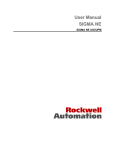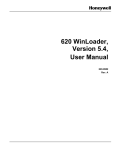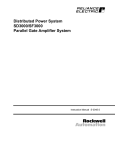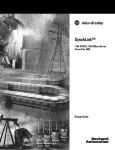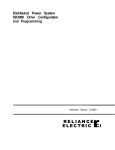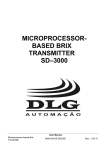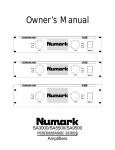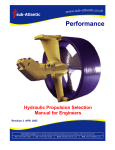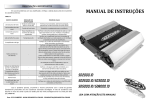Download Distributed Power System Fiber-Optic Cabling
Transcript
Distributed Power System Fiber-Optic Cabling Instruction Manual S-3009-3 Throughout this manual, the following notes are used to alert you to safety considerations: ! ATTENTION: Identifies information about practices or circumstances that can lead to personal injury or death, property damage, or economic loss. Important: Identifies information that is critical for successful application and understanding of the product. The thick black bar shown at the margin of this paragraph will be used throughout this manual to indicate new or revised text or figures. ! ATTENTION: Only qualified personnel familiar with the construction and operation of this equipment and the hazards involved should install, adjust, operate, or service this equipment. Read and understand this manual and other applicable manuals in their entirety before proceeding. Failure to observe this precaution could result in severe bodily injury or loss of life. ATTENTION: The user is responsible for conforming with all applicable local, national, and international codes. Failure to observe this precaution could result in damage to, or destruction of, the equipment. The information in this user’s manual is subject to change without notice. Belden® is a registered trademark of Belden, Inc. ST® is a registered trademark of AT&T. AutoMax™ and PowerMax™ are trademarks of Rockwell Automation. © 1998 Rockwell International Corporation CONTENTS Chapter 1 Introduction 1.1 Related Hardware and Software ..................................................................... 1-1 1.2 Related Publications ........................................................................................ 1-2 1.2.1 1567 Power Max™ Documentation....................................................... 1-3 Chapter 2 Fiber-Optic Cable Assembly Components 2.1 Cable ............................................................................................................... 2-1 2.2 Connectors ...................................................................................................... 2-1 Chapter 3 Fiber-Optic Link Installation 3.1 Optical Power Budget ...................................................................................... 3-1 3.2 Installation Planning ........................................................................................ 3-2 3.3 Installation Guidelines ..................................................................................... 3-3 3.4 Attaching Fiber-Optic Connectors ................................................................... 3-3 3.5 Connecting a Fiber-Optic Cable Between a UDC Module and the PMI .......... 3-4 Chapter 4 Fiber-Optic Link Testing and Troubleshooting 4.1 COMM OK LEDs ............................................................................................. 4-1 4.2 DRV FLT LEDs ................................................................................................ 4-2 Appendix A Fiber-Optic Link Specifications .................................................................................A-1 Appendix B 62.5 Micron Fiber-Optic Cable Specifications...........................................................B-1 Appendix C 50 Micron Fiber-Optic Cable Specifications..............................................................C-1 Appendix D Fiber-Optic Connector Specifications .......................................................................D-1 Appendix E Fiber-Optic Cable Assembly Test Set Specifications ...............................................E-1 Table of Contents I II Fiber-Optic Cabling List of Figures Figure 1.1 – Fiber-Optic Serial Communication Link ................................................ 1-1 Figure 3.1 – A Sample Fiber-Optic Link for Power Budget Calculations .................. 3-1 Figure 3.2 – Fiber-Optic Cable Assembly Connections............................................ 3-5 Figure 3.3 – Fiber-Optic Ports and Connectors ........................................................ 3-6 Table of Contents III IV Fiber-Optic Cabling List of Tables Table 1.1 – DPS Documentation .............................................................................. 1-2 Table 1.2 – Power Max™ Documentation (Binder S-3040)...................................... 1-3 Table of Contents V VI Fiber-Optic Cabling CHAPTER 1 Introduction This manual provides guidelines on the fiber-optic cabling used to connect AutoMax™ Distributed Power System Universal Drive Controllers (UDC) and Power Module Interfaces (PMI). The cable is immune to electromagnetic interference (EMI) and eliminates ground loops. The fiber-optic cable is a part of a point-to-point serial communication link between the UDC module and the PMI. See figure 1.1. The link allows the UDC module to transfer configuration, operating system, and real-time control information to the PMI. The PMI in turn sends feedback and status information to the UDC module. The UDC module is capable of supporting two links operating independently of each other. Data transferred over the fiber-optic link is Manchester-encoded and is transmitted at a rate of 10M bits per second. Fiber-optic link specifications are provided in Appendix A. AutoMax Processor UDC Module PMI P/S Fiber-Optic Cables PMI Figure 1.1 – Fiber-Optic Serial Communication Link 1.1 Introduction Related Hardware and Software • P/N 613613-xxS Fiber-Optic Cable (Cable length (xx) is specified in meters.) • P/N 613613-1S Fiber-Optic Test Cable (One meter test cable with connectors attached.) • P/N 417135-2A Fiber-Optic Coupler 1-1 1.2 Related Publications The documentation that describes the SD3000/SF3000, SA500, SA3000, and SA3100 DPS drives is contained in separate binders. Most of the manuals are tailored to describe the hardware and/or software features in detail for each drive type. Table shows the associated document part number for each drive type. Table 1.1 – DPS Documentation Document Part Number SD/SF3000 Binder S-3000 SA500 Binder S-3002 SA3000 Binder S-3001 SA3100 Binder S-3053 DPS Overview S-3005 S-3005 S-3005 S-3005 UDC Module S-3007 S-3007 S-3007 S-3007 Fiber-Optic Cabling S-3009 S-3009 S-3009 S-3009 Configuration & Programming S-30061 S-30362 S-3044 S-3042 S-3056 Power Module Interface S-3008 S-3018 S-3019 S-3057 Power Module S-3037 S-3018 S-30203 S-30294 S-3058 Diagnostics, Troubleshooting & Start-Up Guidelines S-3011 S-3022 S-3021 S-3059 N/A S-3017 N/A N/A S-3012 S-3024 S-3023 S-3054 Document D-C Bus Supply Information Guide 1. SD3000 1-2 2. SF3000 3. Medium Power 4. High Power Fiber-Optic Cabling 1.2.1 1567 Power Max™ Documentation 1567 Power Max medium voltage AC drives also operate under the control of the AutoMax DPS system. The 1567 Power Max binder (S-3040) contains the following manuals: Table 1.2 – Power Max™ Documentation (Binder S-3040) Document Introduction Document Part Number DPS Overview S-3005 UDC Module S-3007 Fiber-Optic Cabling S-3009 Medium Voltage Inverter S-3041 12-Pulse Diode Rectifier S-3048 PMI Subsystem S-3049 Drive Configuration & Programming S-3050 Liquid Cooling System S-3051 Installation Guidelines S-3052 Drive Information Guidelines S-3046 1-3 1-4 Fiber-Optic Cabling CHAPTER 2 Fiber-Optic Cable Assembly Components Fiber-optic cable assemblies are composed of two main components: the connectors and the cable itself. 2.1 Cable The UDC module and the PMI require a 62.5 micron duplex fiber-optic cable. The recommended 62.5 micron fiber-optic cable is Belden cable #225362, Mohawk cable #M92021, or equivalent. This cable has a PVC outer jacket and an internal Kevlar strength member. This cable is a breakout type of cable which contains two individually insulated fiber-optic wires (fibers). This cable may be used in areas where the ambient temperature will not exceed 80×C (176×F). Note that 50 micron fiber-optic cable is an acceptable substitute for 62.5 micron cable. Refer to Appendices A, B, and C for more information. ! 2.2 ATTENTION: Turn off, lock out, and tag the power to both the rack containing the UDC module and to its corresponding PMI hardware before viewing the fiber-optic cable or transmitter under magnification. Viewing a powered fiber-optic transmitter or connected cable under magnification may result in damage to the eye. For additional information refer to ANSI publication Z136.1-1981. Failure to observe this precaution could result in bodily injury. Connectors The fiber-optic connectors must be ST®-Compatible Multimode Connectors with ceramic ferrules. Refer to Appendix D for more information. A coupler is required when connecting two fiber-optic cables together. An ST-Compatible Multimode Coupler or equivalent is recommended. Refer to Appendix D for more information. Fiber-Optic Cable Assembly Components 2-1 2-2 Fiber-Optic Cabling CHAPTER 3 Fiber-Optic Link Installation The fiber-optic link installation should conform to all applicable codes. ATTENTION: The user is responsible for conforming with all applicable local, national, and international codes. Failure to observe this precaution could result in damage to, or destruction of, the equipment. ! 3.1 Optical Power Budget Fiber-optic communication depends on the launched light signal reaching the receiver at a level high enough to be detected. A power budget calculation determines the amount of losses present in the fiber-optic link and the result is then compared to the total amount of optical power available from the fiber-optic transmitter. The transmitter must be capable of launching more optical power than what is lost in the system. The total amount of optical power (power budget) provided by the fiber-optic transmitters is 2.6dB which includes the losses of the connectors on the module faceplates. The maximum cable length is 750 meters (2500 feet) with 62.5 micron cable and 200 meters (660 feet) with 50 micron cable. The minimum cable length for both 62.5 micron cable and 50 micron cable is 1 meter (3.3 feet). A sample fiber-optic link for power budget calculations is shown in figure 3.1. UDC Module PMI 4.5m Connectors COMM A COMM B 300m Connectors 4.5m XMT XMT RCV RCV XMT Cable Segment Cable Segment Cable Segment RCV Figure 3.1 – A Sample Fiber-Optic Link for Power Budget Calculations As shown in figure 3.1, the sample fiber-optic link is composed of three segments: the end segments are 4.5 meters long while the middle segment is 300 meters. Since the power budget value (2.6dB) has factored in one connector pair already, only two more connector pairs have to be accounted for in the power budget calculation. Fiber-Optic Link Installation 3-1 The main requirement for reliable fiber-optic link operation is that the total system loss must be less than the power budget. Use the following equations to calculate the losses present in the system: Power Budget Calculation • Cable Loss = Total Cable Length x Cable Attenuation (3.5dB/Km) • Connector Loss = # of Connector Pairs x Connector Attenuation (0.6dB) • Total Loss = Cable Loss + Connector Loss Using the example in figure 3.1: • Cable Loss = 1.1dB Total Cable Length (.309Km) x Cable Attenuation 3.5dB/Km • Connector Loss = # of Connector Pairs x Connector Attenuation 1.2dB • Total Loss 2.3 dB 2 additional pairs = Cable Loss 1.1dB 0.6dB + Connector Loss 1.2 dB Since 2.3dB (total loss) is less than 2.6dB (power budget), the system will work as designed. 3.2 Installation Planning Use the following procedure to design a fiber-optic link that will achieve maximum signal isolation and cable protection in a specific environment with minimal fiber-optic cable usage. You will need to select the tools and personnel that are required for fiber-optic cable assembly and installation. Unless you have in-house expertise with fiber-optic cable assemblies and installation, we recommend that you contact an experienced contractor for making up and installing fiber-optic cables. Step 1. Identify the actual location of the UDC module and the PMI(s) using an equipment floor plan. Step 2. Identify the tentative fiber-optic cable route. Route the cables to allow easy access in the future. Step 3. Identify the environmental conditions (temperature, humidity, hazardous chemicals) along the route. Step 4. Determine how to bypass physical obstructions (walkways, heat sources, furnaces, caustic chemicals) along the route. Step 5. Determine the best type of fiber-optic cable installation (conduit, raceway, wiring tray). Refer to R/E 704201-80 in your system documentation for the appropriate method. Step 6. Calculate the total length of the fiber-optic cable. Step 7. Calculate the optical power budget as described in section 3.1. 3-2 Fiber-Optic Cabling Step 8. Document the fiber-optic cable layout. This document should be maintained for the life of the installation. Step 9. Determine the number of fiber-optic cable components that are needed. Refer to Appendices B, C, and D for more information on recommended components. 3.3 Installation Guidelines The fiber-optic cable must be handled by experienced personnel prior to and during installation. Improper handling may result in damage to the cable. ! ATTENTION: The user is responsible for conforming with all applicable local, national, and international codes. Failure to observe this precaution could result in damage to, or destruction of, the equipment. Use the following guidelines to protect the cable: • Label the fiber-optic cable with the network drop, UDC module slot, and channel (either A or B). • Route the fiber-optic cable to protect it from abrasion, vibration, moving parts, and personnel traffic. Be sure the cable does not touch abrasive surfaces such as concrete which could wear through and damage the cable’s outer jacket. • Be sure to locate the fiber-optic cable away from temperatures greater than 80°C (176°F). • Protect the fiber-optic cable from: oil, grease, acids, caustics, and other hazardous chemicals. • The minimum bend radius is 60mm (3”). • Do not exceed the cable’s maximum recommended pulling tension. • Be sure to use a cable pulling lubricant to reduce friction when pulling the cable. 3.4 Attaching Fiber-Optic Connectors Typically, short fiber-optic cables are shipped with their connectors attached. You may need to attach connectors if replacement cables are needed, if the fiber-optic link is being altered, or if the cable is very long. Refer to Appendices B, C, and D for cable and connector specifications. Appendix D also lists the name of the recommended fiber-optic connector kit. This kit contains detailed instructions that describe how to attach the connectors to the fiber-optic cable. Refer to Appendix E for the name of the recommended cable assembly test set. Test the cable after installation or require certification by the contractor. Certification should detail the test results including signal losses. Fiber-Optic Link Installation 3-3 3.5 Connecting a Fiber-Optic Cable Between a UDC Module and the PMI Use the following procedure to connect a fiber-optic cable (P/N 613613-xxS) between the UDC module and the PMI: Step 1. Remove the dust cover caps from the fiber-optic ports on the UDC module and the PMI. Clean the ports with a can of compressed air. Save the dust caps. All fiber-optic connectors and ports, when not in use, should be covered with dust cover caps. Step 2. Remove the dust cover caps from the fiber-optic cable’s connectors. Use a lint-free cloth moistened with isopropyl alcohol or a can of compressed air to clean the cable’s connectors. ! ATTENTION: Do not damage the ends of the fiber-optic cable connectors by touching or dropping them. Do not use factory-compressed air to clean the fiber-optic ports or connectors because the air may contain impurities that could scratch them. Failure to observe this precaution could result in damage to or destruction of the equipment. Step 3. Attach the cable’s connectors to the ports as shown in figure 3.2: • UDC module XMT port: blue fiber-optic wire • UDC module RCV port: orange fiber-optic wire • PMI XMT port: orange fiber-optic wire • PMI RCV port: blue fiber-optic wire Note that the fiber-optic wires are color-coded. Typically, the wires are orange and blue. The wires used in your installation may be of a different color but they should be installed in the same manner as described here. Note that both of the fiber-optic wires are the same. Align the connector’s pin with the slot in the module’s port. See figure 3.3. Push the connector onto the port. Turn the connector clockwise until it locks onto the port’s two pins. Do not bend or kink the wire when you attach it to the port. Bending the wire sharply could break the fiber inside. ! ATTENTION: Turn off, lock out, and tag the power to both the rack containing the UDC module and to its corresponding PMI hardware before viewing the fiber-optic cable or transmitter under magnification. Viewing a powered fiber-optic transmitter or connected cable under magnification may result in damage to the eye. For additional information refer to ANSI Publication Z136.1-1981. Failure to observe this precaution could result in bodily injury. Step 4. If the COMM OK LEDs do not light as described in section 4.1, follow the troubleshooting procedures in that section. 3-4 Fiber-Optic Cabling UNIVERSAL DRIVE CONTROLLER EM 57652 CARD OK OS OK COMM A OK DRV A FLT COMM B OK DRV B FLT TEST SWITCHES PMI 1 2 3 N.O. METER PORTS 1 2 3 4 COM (ORG.) (BLUE) COMM A P2 XMT PMI (XMT) UDC (XMT) UDC (RCV) PMI (RCV) FIBER-OPTIC CABLE RCV COMM B FIBER-OPTIC WIRE (ORG.) C O M M L I N K XMT P3 RCV (BLUE) XMT RCV Figure 3.2 – Fiber-Optic Cable Assembly Connections . Fiber-Optic Link Installation 3-5 ST Connector Slot Pins XMT Pin RCV Figure 3.3 – Fiber-Optic Ports and Connectors 3-6 Fiber-Optic Cabling CHAPTER 4 Fiber-Optic Link Testing and Troubleshooting This chapter describes how to test and troubleshoot the fiber-optic link. 4.1 COMM OK LEDs Under normal operating conditions, i.e., there is an operating system loaded, a UDC module is properly connected to a powered-up PMI, the UDC module’s green COMM OK LED will be on. For the PMI, its COMM OK LED will be turned on when it is properly connected to a powered-up UDC module containing both an operating system and a valid parameter object file. The LEDs will remain on as long as messages are being received correctly on the fiber-optic link. The COMM OK LEDs may be on even though communication errors have been detected. If two or more communication errors of the same type have been received sequentially, or a message has been lost, the COMM OK on the receiving end will go off and will stay off for as long as the condition exists. Note that in this case the DRV FLT LEDs on the UDC module will be turned on as described in section 4.2. Note that the COMM OK LEDs will remain on even though a drive fault has stopped the drive, unless communication errors caused the drive fault. If the COMM OK LEDs on either the UDC module or the PMI are off, there is a problem with the fiber-optic link. The loop-back tests allow you to check the operation of individual parts of the fiber-optic system. To run the loop-back tests you will need a fiber-optic test cable (Reliance P/N 613613-1S) and a fiber-optic coupler (Reliance P/N 417135-2A). You will need to use only one of the test cable’s wires. Note that for diagnostic purposes only, there is sufficient optical power to conduct the loop-back tests which effectively double the length of the fiber-optic link. Use the following loop-back test procedures to isolate the problem: Step 1. Stop all tasks that are running on the UDC module. Remove the existing fiber-optic cable from the PMI’s XMT and RCV ports. Attach one of the wires of the test cable from the XMT port to the RCV port. Cycle power to the PMI. If the COMM OK LED remains off, remove the test cable and replace the PMI. If the PMI’s COMM OK LED lights, remove the test cable and go to step 2. Step 2. Remove the existing fiber-optic cable from the UDC module’s XMT and RCV ports. Attach one of the wires of the test cable from the XMT port to the RCV port. Use the AutoMax Programming Executive’s I/O Monitor to initiate the loop-back test by setting bit 15 of register 101 (drive A) or register 1101 (drive B). Fiber-Optic Link Testing and Troubleshooting 4-1 If the COMM OK LED remains off, remove the test cable and replace the UDC module. If the UDC module’s COMM OK LED lights, turn the loop-back test off by setting bit 15 of registers 101 or 1101 to zero. Then remove the test cable and go to step 3. Step 3. To test the original cable using the UDC module’s fiber-optic transmitter, re-connect the original fiber-optic cable to the UDC module’s ports. Instead of connecting the other end of the fiber-optic cable to the PMI’s XMT and RCV ports, connect the cables together using a fiber-optic coupler (P/N 417135-2A). Use the AutoMax Programming Executive’s I/O Monitor to initiate the loop-back test by setting bit 15 of register 101 (drive A) or register 1101 (drive B). If the UDC module’s COMM OK LED remains off, try replacing the fiber-optic connectors. Re-initiate the loop-back test again. If the COMM OK LED remains off, replace the fiber-optic cable. Re-initiate the loop-back test. If the UDC module’s COMM OK LED does light, turn the loop-back test off by setting bit 15 of registers 101 or 1101 to zero, and go to step 4. Step 4. To test the cable using the PMI’s fiber-optic transmitter, re-connect the fiber-optic cable to the PMI’s ports. Instead of connecting the other end of the fiber-optic cable to the UDC module’s XMT and RCV ports, connect the cables together using a fiber-optic coupler (P/N 417135-2A). Cycle power to the PMI. If the PMI’s COMM OK LED remains off, reconnect the original fiber-optic cable to the UDC module’s ports and re-initialize the AutoMax rack(s). Cycle power to the PMI. If the COMM OK LEDs still do not light, systematically replace the PMI, the UDC module, and the fiber-optic cable. 4.2 DRV FLT LEDs The red DRV FLT LEDs on the UDC module are normally off. If the LEDs are on, check the status of bit 15 of register 202 (drive A) and register 1202 (drive B). If bit 15 is equal to one, the drive fault was caused by a fiber-optic communication problem. Continue with the troubleshooting procedures in section 4.1. 4-2 Fiber-Optic Cabling APPENDIX A Fiber-Optic Link Specifications Maximum Distance • 62.5 micron cable: 750 meters (2500 feet) • 50 micron cable: 200 meters (660 feet) Minimum Distance • 62.5 micron cable: 1 meter (3.3 feet) • 50 micron cable: 1 meter (3.3 feet) Optical Power Budget. • 62.5 micron cable: 2.6dB (includes one pair of connectors) • 50 micron cable: 0.7dB (includes one pair of connectors, no additional connectors are allowed) Fiber-Optic Repeaters • Should not be used to increase the operational distance of the link. Fiber-Optic Link Specifications A-1 A-2 Fiber-Optic Cabling APPENDIX B 62.5 Micron Fiber-Optic Cable Specifications Cable Size • 62.5 micron core, 125 micron cladding, 900 micron buffer Recommended Manufacturer • Belden Belden Part Number • 225362 - breakout cable Number of Fibers per Cable • 2 Outside Diameter • 7mm (.275”) Jacket Material • PVC Operating Temperature • -20° to 80°C -36° to 176°F Maximum Pulling Tension • 68 Kg (150 lbs) Minimum Bend Radius • 60 mm (3”) Maximum Attenuation • 3.5 dB per km Nominal Operating Frequency • 820 nanometers 62.5 Micron Fiber-Optic Cable Specifications B-1 B-2 Fiber-Optic Cabling APPENDIX C 50 Micron Fiber-Optic Cable Specifications Cable Size • 50 micron core, 125 micron cladding, 900 micron buffer Recommended Manufacturer • Belden Belden Part Number • 227302 - breakout cable Number of Fibers per Cable • 2 Outside Diameter • 5mm (.2”) Jacket Material • PVC Operating Temperature • -20° to 80°C -36° to 176°F Maximum Pulling Tension • 68 Kg (150 lbs) Minimum Bend Radius • 60 mm (3”) Maximum Attenuation • 3.5 dB per km Nominal Operating Frequency • 820 nanometers 50 Micron Fiber-Optic Cable Specifications C-1 C-2 Fiber-Optic Cabling APPENDIX D Fiber-Optic Connector Specifications Recommended Fiber-Optic Connector • Hot Melt Connector, ST-compatible Manufacturer • 3M 3M Part Number • 6100 Ferrule • Ceramic Maximum Attentuation • -0.6dB per mated-pair Recommended Connector Termination Kit • Hot Melt Termination Kit, ST-compatible Manufacturer • 3M 3M Part Number • 6150A Recommended Fiber-Optic Coupler • Rockwell/Reliance P/N 417135-2A Fiber-Optic Connector Specifications D-1 D-2 Fiber-Optic Cabling APPENDIX E Fiber-Optic Cable Assembly Test Set Specifications Recommended Cable Assembly Test Set • Fiber-Optic Test Set, ST-Compatible Manufacturer • 3M/Photodyne 3M/Photodyne Part Number • 118 Recommended Test Cable • Reliance P/N 613613-1S Fiber-Optic Cable Assembly Test Set Specifications E-1 E-2 Fiber-Optic Cabling DIF Documentation Improvement Form Use this form to give us your comments concerning this publication or to report an error that you have found. For convenience, you may attach copies of the pages with your comments. After you have completed this form, please return it to: Rockwell Automation RGA (Technical Publications) 25001 Tungsten Road Cleveland, Ohio 44117 Fax: 216.266.7120 Publication Name: Publication Number: Publication Date: Comments: Your Name: Date: Company Name: Phone: ( ) Address: Thank you for your comments. Technical Writing Internal Use Date: Follow-Up Action: DIF Number: Rockwell Automation / 24703 Euclid Avenue / Cleveland, Ohio 44117 / (216) 266-7000 Printed in U.S.A. S-3009-3 March 1998




































